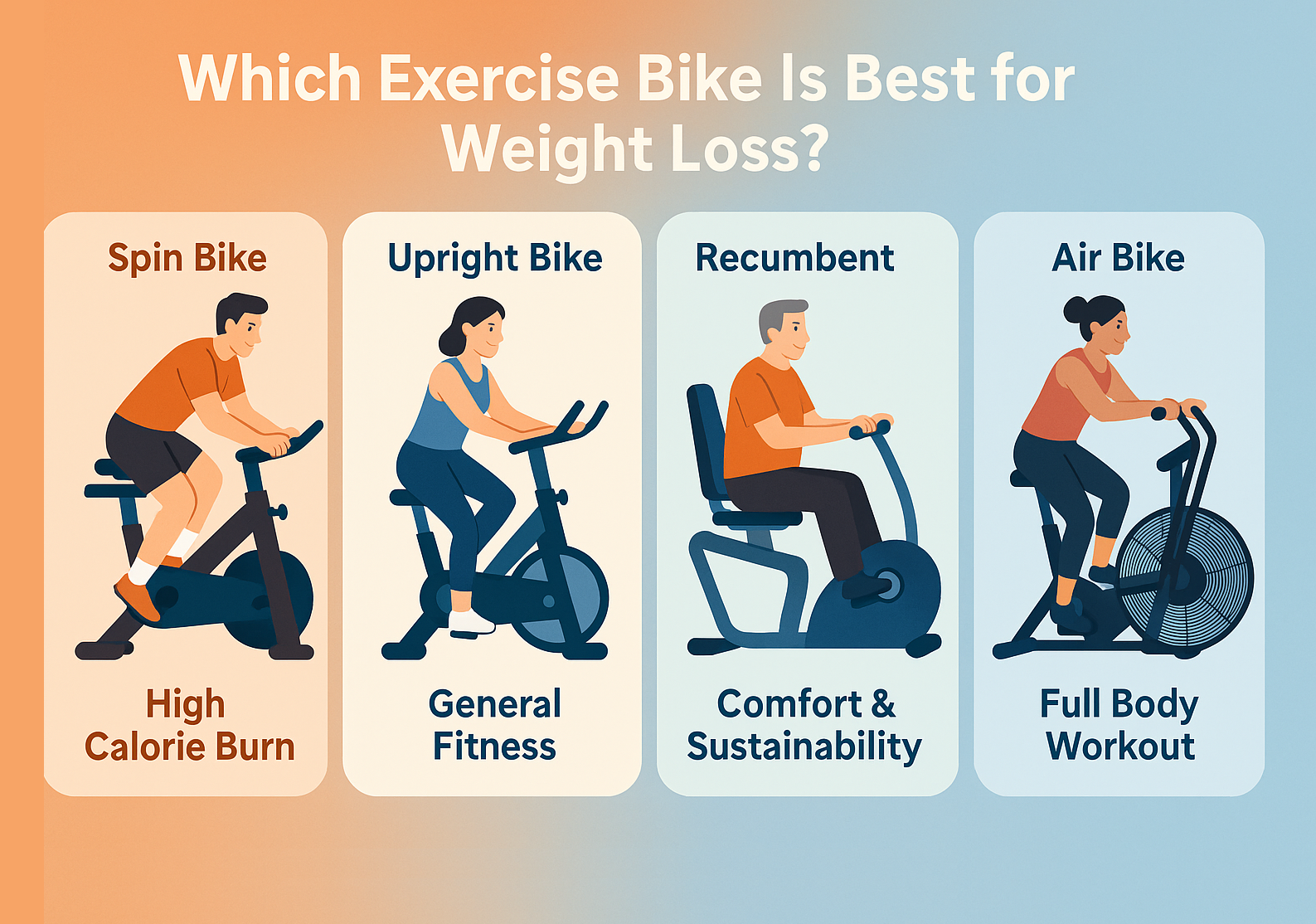Have you ever found yourself at the gym, staring at a row of bikes, and wondering, “Which one should I choose?” Spin bikes and exercise bikes might look similar, but they offer different experiences and benefits.
Understanding these differences can help you make the best choice for your fitness journey. We’ll break down the unique features of each bike, so you can decide which one aligns with your workout goals. Whether you’re aiming to shed pounds, build endurance, or simply stay active, knowing the right bike to use can make all the difference.
Stay with us, and you’ll be well on your way to making an informed decision that enhances your fitness routine.
Spin Bike Basics
Spin bikes and exercise bikes look similar but serve different purposes. Both help improve fitness through cycling workouts.
This guide explains how spin bikes differ from exercise bikes by focusing on their design, features, and workout styles.
Design And Build
Spin bikes have a heavy flywheel in the front for smooth pedal motion. They often have a sturdy frame to handle intense workouts.
Exercise bikes usually have a lighter flywheel or magnetic resistance. They often come with a more upright design for comfort.
- Spin bikes: heavy flywheel, strong frame, forward-leaning seat
- Exercise bikes: lighter flywheel, upright seat, cushioned design
Typical Features
Spin bikes have adjustable resistance using a knob or lever. They usually do not have fancy screens or built-in programs.
Exercise bikes often include digital displays, heart rate monitors, and preset workout programs. They focus on user comfort.
- Spin bikes: manual resistance control, no screen, basic design
- Exercise bikes: digital display, preset workouts, heart rate sensors
Workout Style
Spin bikes are built for high-intensity training. They mimic road biking and allow standing or seated positions.
Exercise bikes offer low-impact, steady workouts. They suit beginners or people who want a relaxed cycling session.
- Spin bikes: intense workouts, standing and seated riding
- Exercise bikes: gentle workouts, mostly seated riding

Exercise Bike Essentials
Exercise bikes help improve fitness and health. They offer a low-impact workout for all ages.
Choosing the right bike depends on your needs. Understanding key features can guide your choice.
Types Of Exercise Bikes
There are mainly two types of exercise bikes: spin bikes and exercise bikes. Spin bikes mimic road bikes with a heavier flywheel. Regular exercise bikes include upright and recumbent styles.
- Spin Bikes:Designed for intense workouts and speed control.
- Upright Bikes:Resemble standard bikes with a vertical seating position.
- Recumbent Bikes:Feature a reclined seat for comfort and back support.
Key Components
| Component | Spin Bike | Exercise Bike |
|---|---|---|
| Flywheel | Heavy, creates smooth resistance | Lighter, less smooth motion |
| Seat | Narrow and firm | Wider and cushioned |
| Handlebars | Multiple grip positions | Simple and fixed |
| Resistance | Manual or magnetic | Usually magnetic or motorized |
Common Uses
Spin bikes suit high-intensity training and group classes. Exercise bikes are good for steady cardio and rehab.
- Spin bikes help build endurance and strength.
- Upright bikes improve general fitness and burn calories.
- Recumbent bikes support low-impact exercise for seniors or injured users.
Comparing Workout Experience
Spin bikes and exercise bikes both help you get fit by cycling indoors. They look similar but feel different during workouts.
Understanding their workout experience can help you choose the right bike for your needs.
Intensity Levels
Spin bikes offer higher intensity workouts. You can pedal very fast and increase resistance easily.
Exercise bikes usually provide lower to moderate intensity. They are good for steady and gentle exercise.
- Spin bikes let you stand and pedal hard
- Exercise bikes keep you seated mostly
- Spin bikes have adjustable resistance for tough workouts
- Exercise bikes focus on smooth, steady pedaling
Comfort And Ergonomics
Exercise bikes offer more comfort. They have wider seats and backrests for support.
Spin bikes have smaller seats and a more forward position. They are less comfy but better for intense workouts.
- Exercise bikes suit longer sessions with comfort
- Spin bikes fit shorter, harder rides
- Exercise bikes often have adjustable seats and handlebars
- Spin bikes focus on a racing posture
Noise And Smoothness
Spin bikes tend to be quieter and smoother. Their flywheel creates a smooth pedal motion.
Exercise bikes may have more noise from the motor or belt. The pedal motion can feel less smooth.
- Spin bikes use heavy flywheels for smooth cycling
- Exercise bikes vary by model in noise levels
- Spin bikes are good for quiet environments
- Exercise bikes can be louder but still effective
Fitness Goals And Suitability
Spin bikes and exercise bikes help improve fitness but serve different needs. Choosing the right bike depends on your goals and fitness level.
Both bikes offer cardio workouts, but they vary in style, intensity, and comfort. Understanding these differences helps you pick the best option.
Weight Loss And Cardio
Spin bikes provide intense cardio workouts that burn many calories fast. They mimic real cycling with standing and sprinting options.
Exercise bikes give steady, low-impact cardio. They suit people who want less strain and longer sessions.
- Spin bikes help burn more calories quickly
- Exercise bikes support longer, gentle cardio
- Spin bikes improve heart and lung fitness fast
- Exercise bikes are easier for beginners and seniors
Strength And Endurance
Spin bikes build leg strength by using heavier resistance. Riders can stand and pedal hard for muscle endurance.
Exercise bikes offer lighter resistance and focus on endurance. They help keep muscles active without heavy strain.
- Spin bikes increase leg power and stamina
- Exercise bikes improve muscle endurance gently
- Spin bike workouts can be short but intense
- Exercise bikes fit longer, steady workouts
Rehabilitation And Low Impact
Exercise bikes are better for rehab because they are low impact. They reduce joint stress and support slow recovery.
Spin bikes are less suited for rehab due to higher intensity and harder pedaling. They are best after full recovery.
- Exercise bikes protect knees and hips during rehab
- Spin bikes require good joint health
- Exercise bikes allow slow, controlled movement
- Spin bikes demand more balance and strength
Price And Maintenance
Spin bikes and exercise bikes both help you stay fit at home. They look similar but differ in price and care needs. Knowing these differences helps you choose the right one.
Let’s explore how much each costs and what maintenance they require.
Cost Differences
Spin bikes usually cost more than exercise bikes. This is because spin bikes have stronger frames and heavier flywheels. Exercise bikes are simpler and often cheaper.
- Spin bikes: $300 to $1,000 or more
- Exercise bikes: $100 to $600
Choosing depends on your budget and how often you will use the bike.
Durability
Spin bikes are built for intense workouts. They use strong materials and heavy parts. This makes them last longer under tough use.
Exercise bikes are lighter and less sturdy. They may wear out faster if used hard or often.
- Spin bikes have metal frames and heavy flywheels
- Exercise bikes use lighter materials and smaller parts
- Spin bikes suit frequent and heavy use
- Exercise bikes fit light to moderate use
Upkeep Needs
Spin bikes need regular checks for parts like chains or belts. You may need to lubricate or tighten parts often. This keeps the bike working smoothly.
Exercise bikes require less care. Most parts are sealed and need little attention. Cleaning and checking bolts is usually enough.
- Spin bikes: check chain, pedals, and bolts monthly
- Exercise bikes: clean and check bolts every few months
- Spin bikes may need part replacement over time
- Exercise bikes have fewer moving parts to maintain

Choosing The Right Bike
Choosing between a spin bike and an exercise bike depends on your needs. Both help you stay active but have different designs and uses.
Think about your space, preferences, and features before buying. This guide helps you find the best fit for your home workouts.
Space And Portability
Spin bikes usually take more space and are heavier. They are made for steady places like a home gym.
Exercise bikes are lighter and often smaller. You can move them easily and store them in tighter spots.
- Spin bikes need more floor space
- Exercise bikes fit in smaller rooms
- Exercise bikes are easier to carry
- Spin bikes stay in one place
User Preferences
Spin bikes suit people who want intense workouts. They offer a real cycling feel with fast pedaling and standing options.
Exercise bikes are good for light to moderate exercise. They often have comfortable seats and adjustable settings for easy use.
| Feature | Spin Bike | Exercise Bike |
| Workout Type | High intensity | Low to moderate intensity |
| Seat Comfort | Firm, racing style | Wide and cushioned |
| Pedal Style | Clip-in or flat | Flat pedals with straps |
| Exercise Position | Standing or sitting | Sitting only |
Additional Features
Spin bikes focus on durability and resistance control. They often lack extra tech features.
Exercise bikes may include digital screens, heart rate monitors, and preset programs. These help track progress and add variety.
- Spin bikes: strong frame, manual resistance
- Exercise bikes: digital displays, preset workouts
- Exercise bikes: heart rate sensors, built-in fans
- Spin bikes: simple design, focus on workout intensity

Frequently Asked Questions
What Are The Main Differences Between Spin And Exercise Bikes?
Spin bikes offer a heavier flywheel and a more intense workout. Exercise bikes focus on comfort with adjustable resistance and seating. Spin bikes mimic outdoor cycling, while exercise bikes suit casual riders and beginners.
Which Bike Is Better For Weight Loss?
Spin bikes provide a high-intensity workout that burns more calories. Exercise bikes offer moderate intensity, good for steady fat burning. For faster weight loss, spin bikes are generally more effective.
Are Spin Bikes Louder Than Exercise Bikes?
Spin bikes tend to be louder due to their heavy flywheel and belt system. Exercise bikes use quieter magnetic resistance mechanisms. Noise level depends on the bike model and build quality.
Can Beginners Use Spin Bikes Safely?
Yes, beginners can use spin bikes but should start slowly. Proper form and gradual intensity increase are crucial to avoid injury. Exercise bikes might be more comfortable for absolute beginners.
Conclusion
Spin bikes and exercise bikes serve different workout needs. Spin bikes offer intense, fast-paced sessions like cycling classes. Exercise bikes provide a gentler, steady workout for all fitness levels. Choosing depends on your goals and comfort. Both help improve heart health and burn calories.
Think about space, budget, and how often you’ll use it. Either bike can boost your fitness journey effectively. Simple, consistent exercise leads to better health. Pick the bike that fits your lifestyle best. Keep moving and enjoy your workouts!



